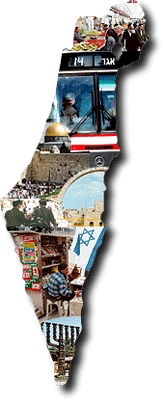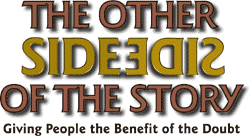Light Lines - Pinchas
Parshat Pinchas
19 Tammuz 5759 / July 3, 1999
Ohr Somayach Home Page
In the Book of Ruth, Boaz greets the harvesters by saying "Shalom," one of G-dís names. From here we learn that a Jew may use G-dís name as a greeting, and it is not considered taking Heavenís name in vain. In fact, there is an opinion that we are obliged to greet each other with G-dís name by saying "Shalom." Why should we be obliged to greet each other using G-dís name? Whatís wrong with "Good Morning" or "Have a nice day"?
Sometimes we look at other people and we think that we are a million miles from them. But no man is an island. When two people meet, the essence of their meeting is to make each other more complete. The fundamental principle of interpersonal relationships is that when I meet my fellow being, I am coming to effect his or her shleimut, meaning completion or wholeness, from the same root as shalom.
Another more commonly known meaning of the word shalom is Ďpeace.í
G-d placed us in a world which demands to be perfected. Our whole relationship with the world and everything in it is a "Peace Process" ó a process of bringing every person and every blade of grass to a state of shleimut ó the true definition of peace.
In Parshat Vayetze, Jacob lays his head down to sleep on some stones. The Midrash says that the stones all vied to be the stone on which Jacob laid his head. The result was that all the stones gathered together and became one stone.
What is the Midrash teaching us? The message of the stones is that completion results from the connection of disparate entities into a single whole.
When we connect with other people on whatever level, whether in business or in marriage, whether in school or on the street, our relationship with them must be with the intention of helping the other person reach a state of completion. Thatís why a Jew is obliged to greet others with "Shalom!" For when we seek to bring each other to a state of completion, to shalom, the world reaches its ultimate fulfillment.
And thatís the real peace process.
Light Insight | Love of the Land | The Other Side of the Story | Response Line Ohr Somayach Home Page |
 Selections from classical Torah sources which express the special relationship between the People of Israel and Eretz Yisrael Yam Hamelach (The Dead Sea) At the lowest point on the earthís surface, about 394 meters below sea level, lies the Yam Hamelach. It is known around the world as the Dead Sea, because no fish can live in it and its mineral substances destroy almost all organic life. A fascinating explanation of how this unusual sea came into being is offered by the great Biblical commentator Rabbi Meir Leibush Malbim. When Abraham parted company with his nephew Lot, the latter is reported to have lifted his eyes and looked at "the entire Jordanian plain, which was entirely irrigated before G-d destroyed Sodom and Amorrah." (Genesis 13:10) The Jordan River once supported a fertile delta valley, compared at the conclusion of this passage to the famous Nile Delta and the "Garden of G-d" in Eden. It was the richness of this well-watered land that originally attracted Lot to settle in its principal city, the wicked Sodom. When G-d destroyed Sodom and its sister cities, this plain turned into a giant crater which became filled by the water of the Jordan running into it. The salt and other minerals contained in the depths of the earth combined with the Jordan waters to form the Dead Sea. The exploitation of approximately 50 million tons of magnesium chloride, sodium chloride, calcium chloride, potassium chloride and magnesium bromide in the sea was initiated in the early 1930ís, and today major commercial enterprises farm the site for minerals and for the production of health care products. It is also a considerable attraction for tourists and those seeking cures in its mineral-rich waters for all manner of ailments. |
Light Insight | Love of the Land | The Other Side of the Story | Response Line Ohr Somayach Home Page |
Marital harmony is one of Judaismís highest ideals. Therefore, the mitzvah to judge favorably has particular importance in the way a married couple relates to one another. When a husband leaves the house, for example, we should assume that his wife says something pleasant like, "See you later, alligator!" and not...
Hereís a great "Other Side" story that I hope youíll enjoy, and everyone will learn something from.
We live in a small town in Israel, and one evening while I was out, my wife discovered that a small lizard (a gecko) had gotten into our apartment. It was on the ceiling in the living room, and she desperately wanted to get it out of the house.
She got a broom and started chasing it and yelling at it. She was unaware that one of our neighbors was coming up the stairs in the hallway outside just as she was screaming at the lizard, "Get out of here, Iím not going to sleep in this house with you here tonight, get out!"
Although my wife and I both had a good laugh about it later, imagine what my neighbor must have thought, as he sheepishly turned around and headed back down the stairs.
Light Insight | Love of the Land | The Other Side of the Story | Response Line Ohr Somayach Home Page |
Tamar Tessler wrote:
We have a custom in our family to color eggs for Lag Bíomer, and we know of others around the world that have this custom, too. Yet nobody seems to know the origin or source of it. Some people I have asked suggested it is taken from a pagan custom, G-d forbid. Can you shed light on this for us, please?
Dear Tamar,
I asked your question of Rabbi Eliezer Demari of Jerusalem. (His parents came to Israel from Yemen in 1949.) Rabbi Demari said that in Yemen, the Jews painted eggs in honor of Purim. They sent these eggs to friends as mishloach manot gifts and ate them at the festive Purim meal.
The Jewish community in Yemen was isolated for centuries, and they can trace many of their customs back to the time of the First Temple, so itís clear that they didnít adopt this practice from any other culture.
Rabbi Demari also noted that itís conceivable that egg-painting was a custom among European Jews, and that they stopped doing so when it was adopted by other religions.
Produced by the Office of Communications
Editor: Raphael Scott Leban
Production: Eliezer Shapiro
Light Insight: Yaakov Asher Sinclair
HTML Design: Michael Treblow
HTML Production: Eli Ballon
© 1999 Ohr Somayach International - All rights reserved. This publication may be distributed to another person intact without prior permission. We also encourage you to include this material in other publications, such as synagogue newsletters. However, we ask that you contact us beforehand for permission, and then send us a sample issue.
This publication is available via E-Mail
Ohr Somayach Institutions is an international network of Yeshivot and outreach centers, with branches in North America, Europe, South Africa and South America. The Central Campus in Jerusalem provides a full range of educational services for over 685 full-time students.









